In the wild, brackish water conditions occur where freshwater streams or rivers meet coastal saltwater. The result is a mix of the two and a shift in salinity.

Some fish thrive in these conditions and spend their entire lives there. Others spend one stage or another of their lives in brackish water.
A brackish aquarium can be a fun undertaking. Just as a reef tank has saltwater fish adapted to that environment, a brackish aquarium has a range of water conditions and fish adapted to various salinity levels.
You can adjust these levels using commercial aquarium marine salt.
Maintaining consistent salinity is vital to your fish’s health, and regular use of a refractometer or hydrometer can help.
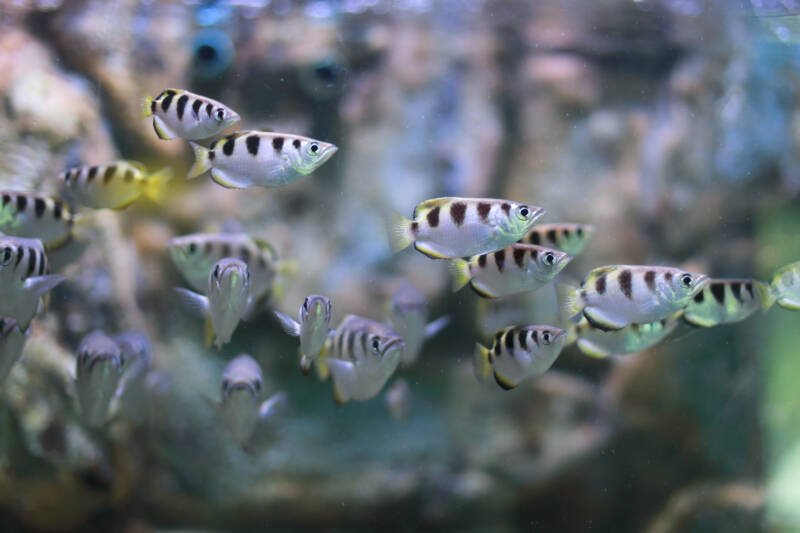
For your aquarium, you need to select fish that can tolerate and thrive in brackish water. The following is a list of 19 brackish water fish to consider.
1. Bumblebee Goby

Specific Gravity: 1.002 to 1.006
Minimum Tank Size: 10 gallons
The bumblebee goby (Brachygobius doriae) has a black body with vertical stripes that are clear to yellow or orange and bright yellow/gold on the head.
Their native habitat is Southeast Asia, specifically Vietnam, Thailand, and Indonesia. This tiny species grows to a maximum length of one inch (2.5 cm).
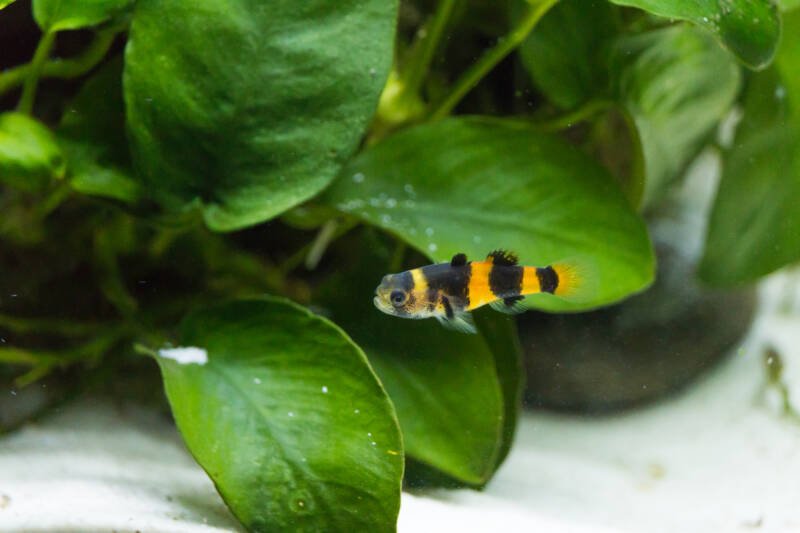
In addition to their brackish water needs, there are some challenges to keeping bumblebee gobies. These fish can be picky eaters and may refuse dry food or only take live, meaty foods.
Due to their small size, it is difficult to find brackish water tankmates that will not view them as food.
2. Colombian Shark Catfish

Specific Gravity: 1.010 to 1.012
Minimum Tank Size: 250 gallons
The sleek body and pointed dorsal fin of the Colombian shark catfish (Hexanematichthys seemanni) may trick you at first, but it is indeed a catfish.
It has a silver body and white-tipped fins on its underside.
These fish start their lives in freshwater in the wild, but to thrive, must move to brackish or marine conditions.
This fish gets big, up to 14 inches (35 cm) in length. It loves to school and is most comfortable in groups of at least three to four.
The Colombian shark catfish is active during the day, is peaceful, and will get along well with similarly sized fish of a gentle nature. They can live up to 15 years.
3. Archer Fish
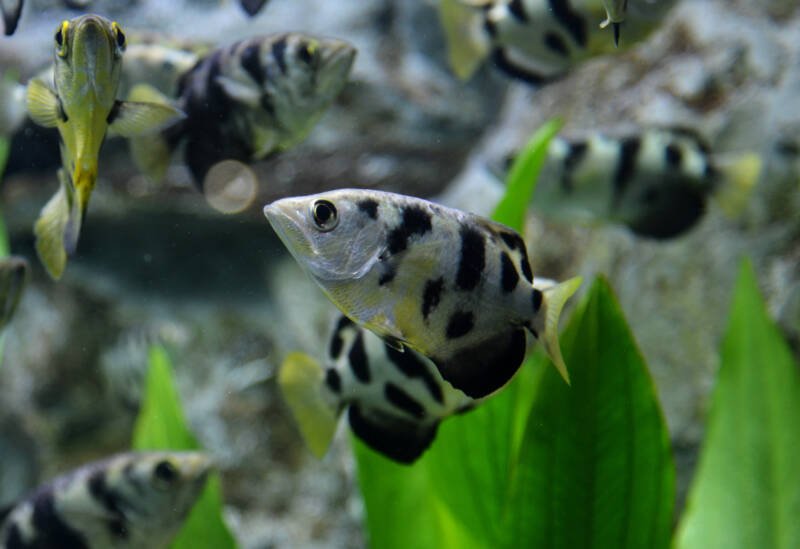
Specific Gravity: 1.002 to 1.010
Minimum Tank Size: 110 gallons
The archerfish (Toxotes jaculator) hunts by forcefully spraying water into the air, hitting its insect target, and predicting where its prey will land.
They gauge the distance to their target and adjust the water stream accordingly.
This fish comes from the waters of Asia, India, and the Philippines. It has silvery sides with vertical black bars, large eyes, and a turned-up mouth.
They grow to 12 inches (30 cm) in length in the wild, but in an aquarium, they are in the five-to-seven-inch (12 to 18 cm) range.
Because they love to hunt, they do well in a paludarium, a tank with above and below water features.
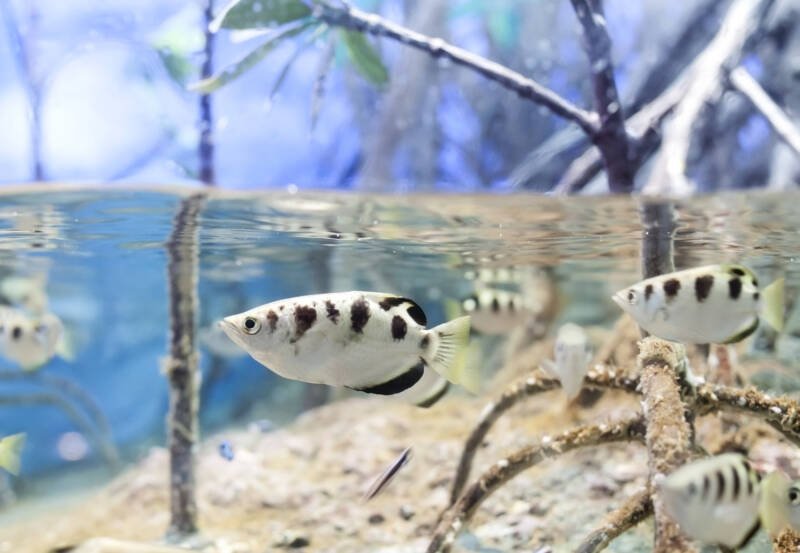
This allows you to place plants above the water line and feed your archerfish by placing live insects in the enclosure.
4. Mollies
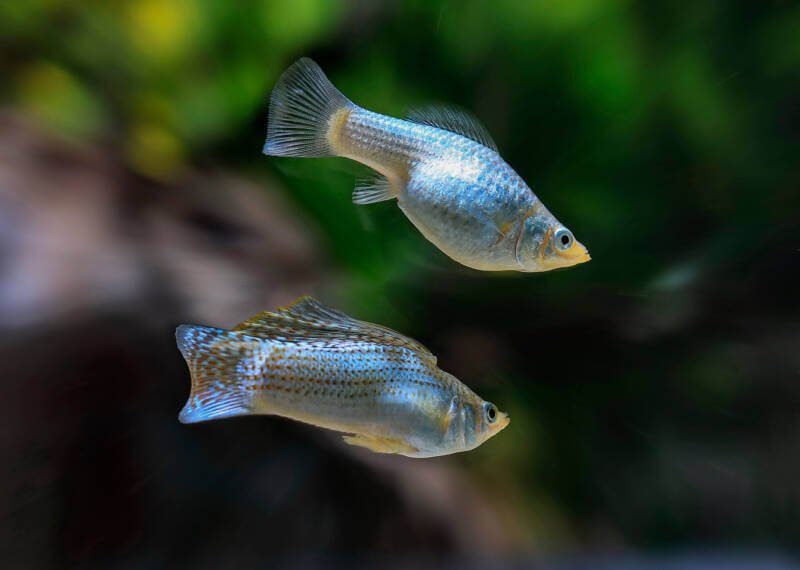
Specific Gravity: 1.005 to 1.020
Minimum Tank Size: 20 to 30 gallons
There are many varieties of mollies within the genus Poecilia, with differences in colors, body shapes, and fins.
Wild mollies grow to a length of five inches (12.7 cm). However, those bred for aquarium trade max out at three to four inches (7.6 to 10 cm).
Mollies do well in groups and produce a good amount of waste, so consider a larger tank with a decent filtration system.

The molly is both a brackish and freshwater fish. Talk with the breeder to determine in which type of water they were raised.
These are warm-water fish, needing a temperature of 75 to 80 degrees Fahrenheit (24 to 27 degrees C). Install a heater to keep the temperature consistent.
5. Scat Fish

Specific Gravity: 1.020 to 1.025
Minimum Tank Size: 120 gallons
Scat fish come from the coastal regions of Australia and Southeast Asia.
Their green to brown colored bodies are compressed and square-shaped with spots of either black or brownish-red.
Take care with this fish, as its dorsal rays contain a mild poison. Another large brackish water fish grow to 10 inches (25 cm) in length.
Because they love to school in groups of six or more, they will require a large aquarium.
These are active swimmers, so make sure there is plenty of open swimming space. Do not include java ferns, as they are toxic to scat fish.
6. Mono Fish (Monodactylus)
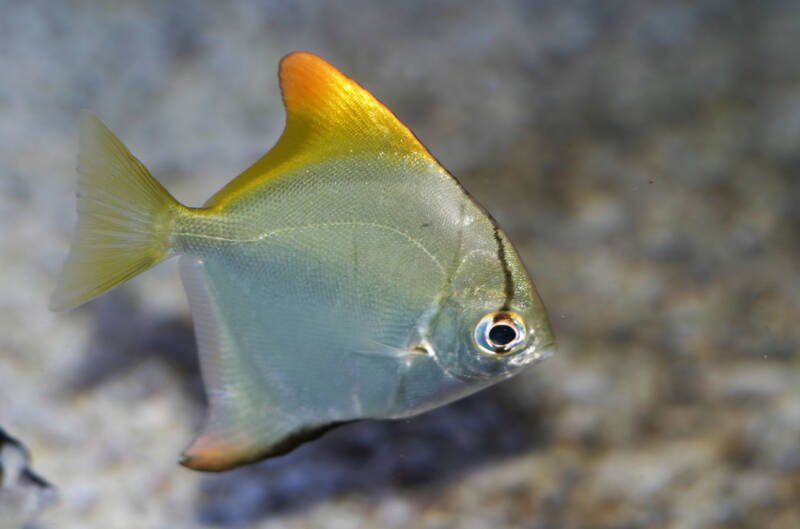
Specific Gravity: 1.002 to 1.007
Minimum Tank Size: 100 gallons
The mono fish (Monodactylus argenteus) has a diamond-shaped body with pointed dorsal and anal fins.
Its body is silver in color, blending into yellow on the fins with two vertical black stripes near the front half of the body.
They are strong, active swimmers that, in the wild, navigate coastal mangroves and tidal rivers in the Indian Ocean region.
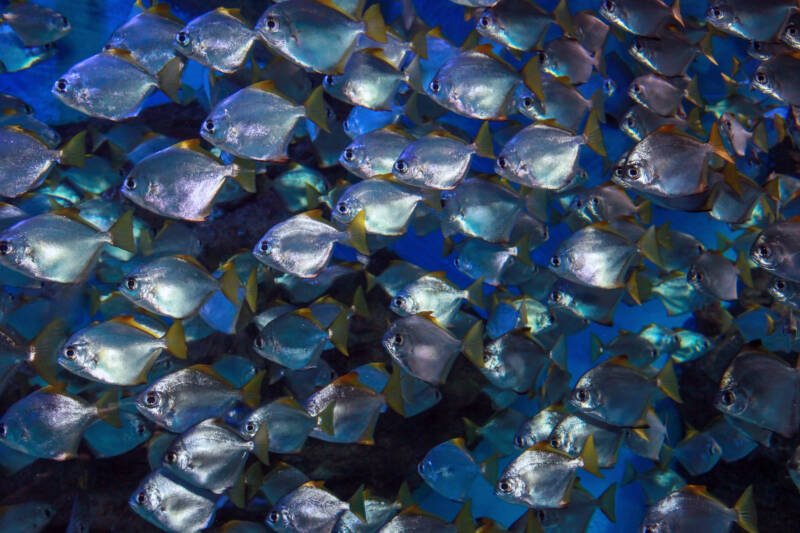
This hardy fish grows to a maximum length of 11 inches (28 cm) and requires a large tank. Keep them in groups of six or more to allow natural schooling behavior.
They require moderate water movement and regular tank maintenance to keep the water clean.
7. Mudskipper (Indian and African)
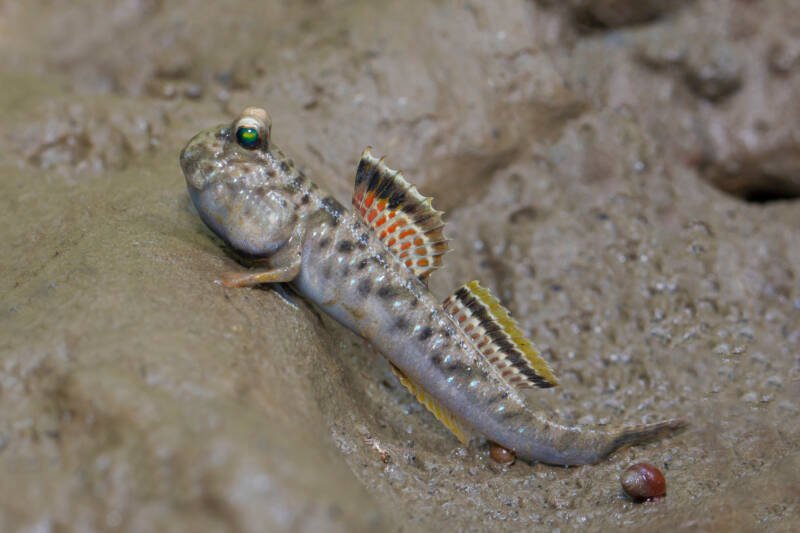
Specific Gravity: 1.003 to 1.015
Minimum Tank Size: 20 gallons (for a single mudskipper)
These creatures have adapted gill covers to permit extended periods out of water.
Their modified pelvic, anal, and pectoral fins allow them to scoot across land and even climb!
Although wild mudskippers can grow up to 12 inches (30.5 cm) in length, the aquarium trade varieties typically reach six inches (15 cm). The males of the species can be very territorial.
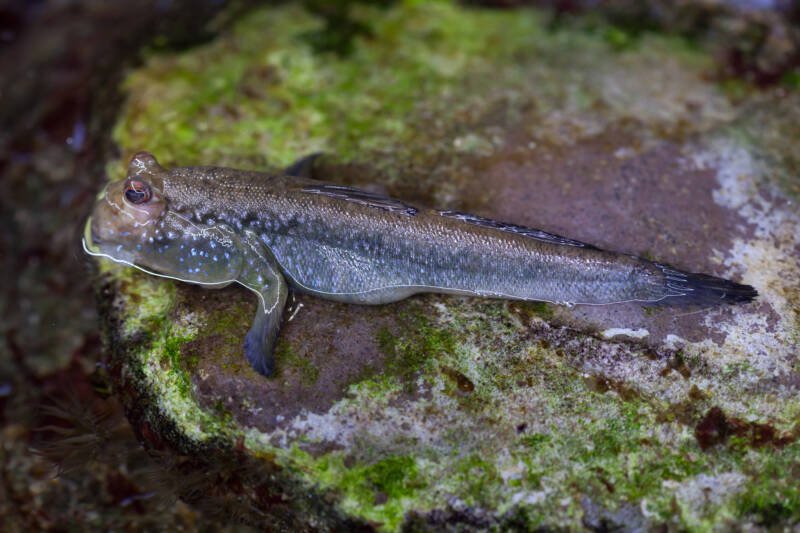
This fish will require a paludarium with areas dedicated to dry land and to water. Make sure that the water gets shallow toward the land areas to provide easy access.
These fish prefer warmer waters, anywhere from 75 to 85 degrees Fahrenheit (24 to 29°C).
8. Cichlid Chromides
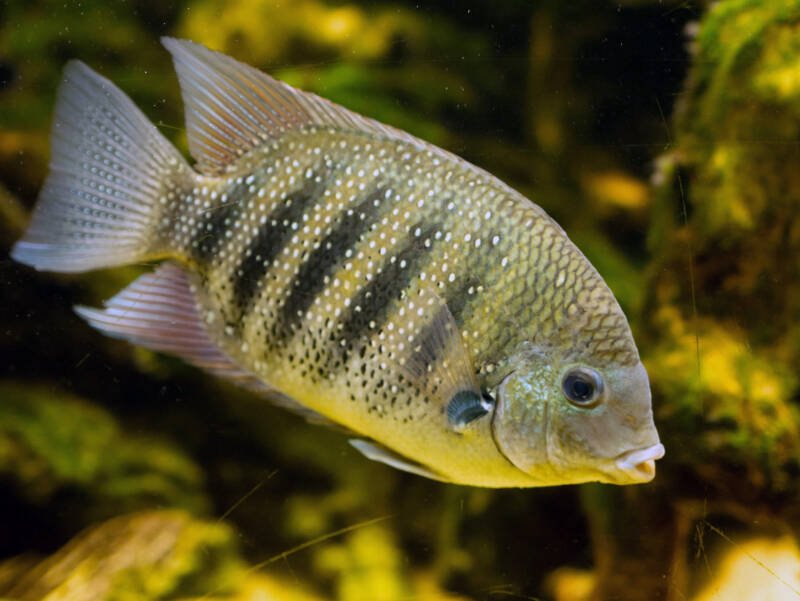
Specific Gravity: 1.002 to 1.010 for orange and 1.005 to 1.012 for green
Minimum Tank Size: 10 gallons (orange) 100 gallons (green)
Many wild cichlid species enter brackish water from time to time; however, only the orange (Etroplus maculatus) and green cichlid chromides (Etroplus suratensis) are fully brackish water fish.
Hailing from South Asia’s waters, they get along well together when they are not breeding but can become territorial.
The orange chromide is the smaller of the two, measuring 3.1 inches (8 cm). This versatile fish can be kept singly, in groups, or in pairs.
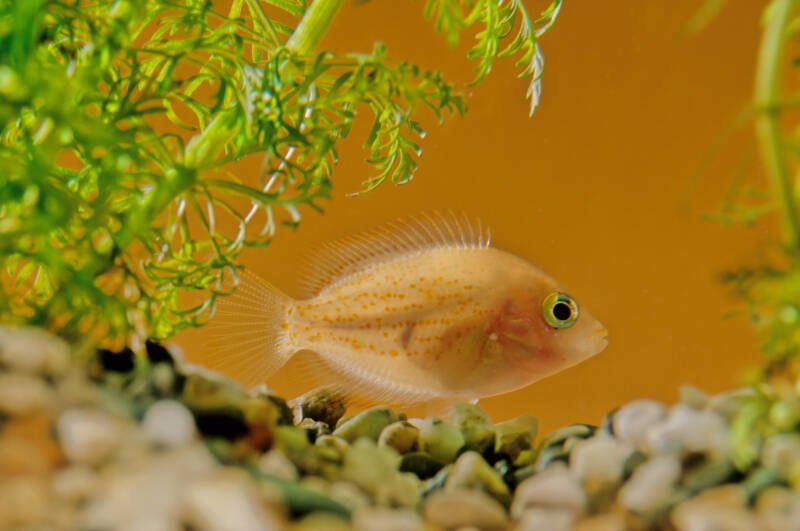
However, the green chromide gets much bigger, maxing out at almost 12 inches (30 cm). Keep this one in a large aquarium with a group so it can school.
9. Indian Glass Fish
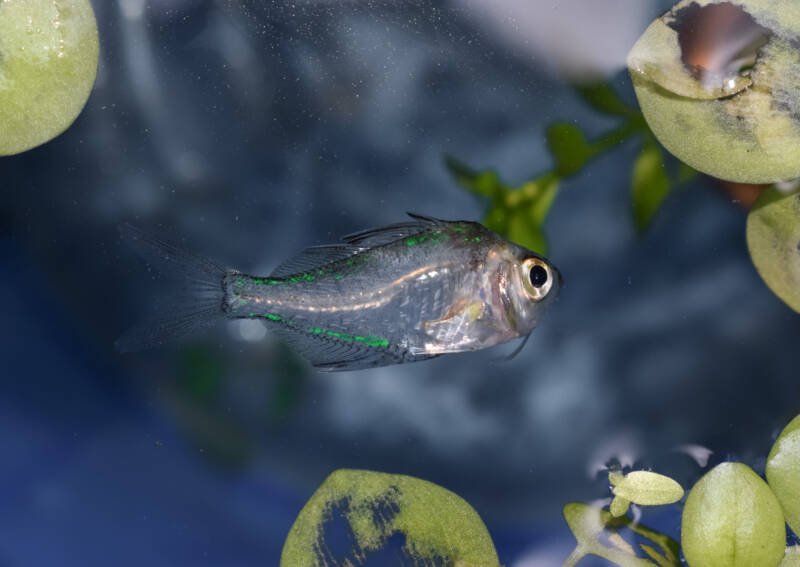
Specific Gravity: 1.002 to 1.007
Minimum Tank Size: 30 gallons
The Indian glass fish (Parambassis ranga) is a member of the glass perch family and grows to a maximum length of three inches (7.6 cm).
Its body is translucent, and you can easily see its spine and organs.
Because of this transparency, some sellers will inject the fish with a fluorescent dye. This practice makes the fish prone to infection and significantly shortens their lifespan.
While many glass fish are kept in freshwater, you can keep this fish in brackish water with low salinity.
The glass fish has energy to spare, is quite playful but not aggressive. It does best in groups of five or more to allow schooling.
10. Guppies

Specific Gravity: 1.003 to 1.010
Minimum Tank Size: 4 gallons (for 3 guppies, add one gallon for each additional guppy)
The guppy is another from the genus Poecilia that can live in both freshwater and brackish.
This tiny fish has a very small bioload and can be kept in smaller tanks but still loves room to swim.
They do best in groups of a minimum size of three and are very active.
These are hardy fish that can tolerate a water temperature range between 50- and 84-degrees Fahrenheit (10 to 29 degrees C), although consistent water parameters are important to their health.
Guppies are popular with aquarium keepers due to their graceful fins, stunning array of colors, and lively personalities.
11. Green Spotted Puffer
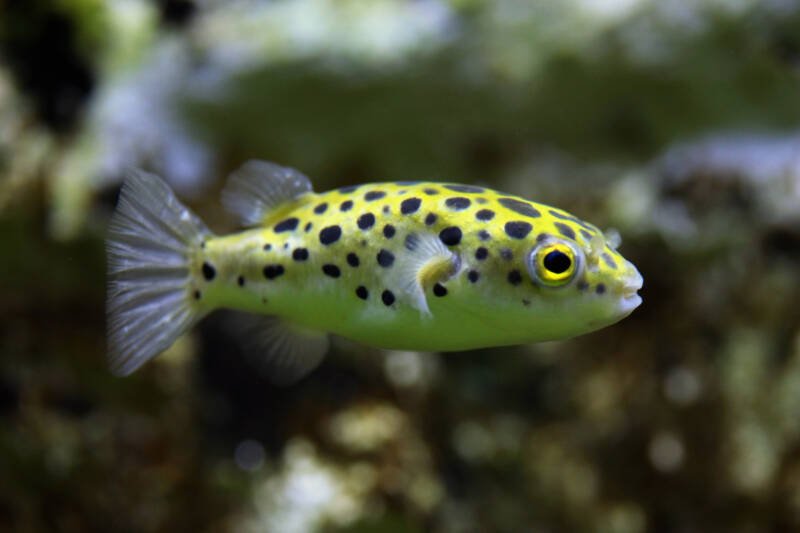
Specific Gravity: 1.005 to 1.20
Minimum Tank Size: 30 gallons
The green spotted puffer (Tetraodon nigroviridis) is an active, intelligent fish with the personality of a great, interactive pet.
This fish comes from the waters of Borneo and Sumatra. It has a white belly and a green-tinted back with numerous black spots.
This carnivore’s beak-like teeth grow continuously and must be ground down by the crustaceans and snails that are an important part of its diet.
The green spotted puffer grows up to six inches (15 cm) in length and can be quite aggressive as an adult. They are long-lived and will be a part of your aquarium for up to 10 years.
12. Figure 8 Puffer or Eyespot Puffer
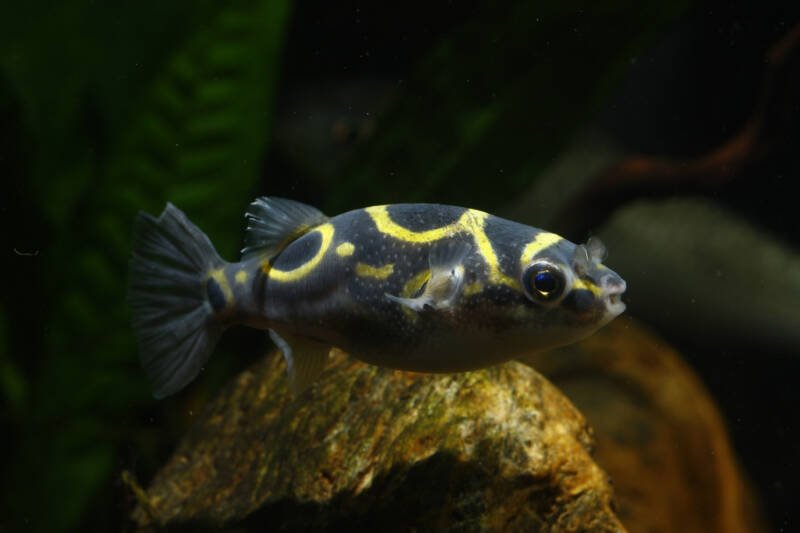
Specific Gravity: 1.005 to 1.008
Minimum Tank Size: 15 gallons (for one fish), 10 gallons more for each additional
Figure 8 puffer (Tetraodon biocellatus), also known as the eyespot puffer, originates from brackish streams in Asia and India.
It has a dark green or brown back, white underside and is accented with black spots and swirls outlined in bright yellow.
Eyespot puffer grows to a maximum size of three inches (7.6 cm) and has a long lifespan of up to 15 years.
These fish are classified as semi-aggressive toward their own kind and can be fin nippers with other species.
As such, they are best kept singly or in a species-only tank. If you plan to add more puffers, make sure there are plenty of hiding places.
13. Stars and Stripes Puffer or White-Spotted Puffer
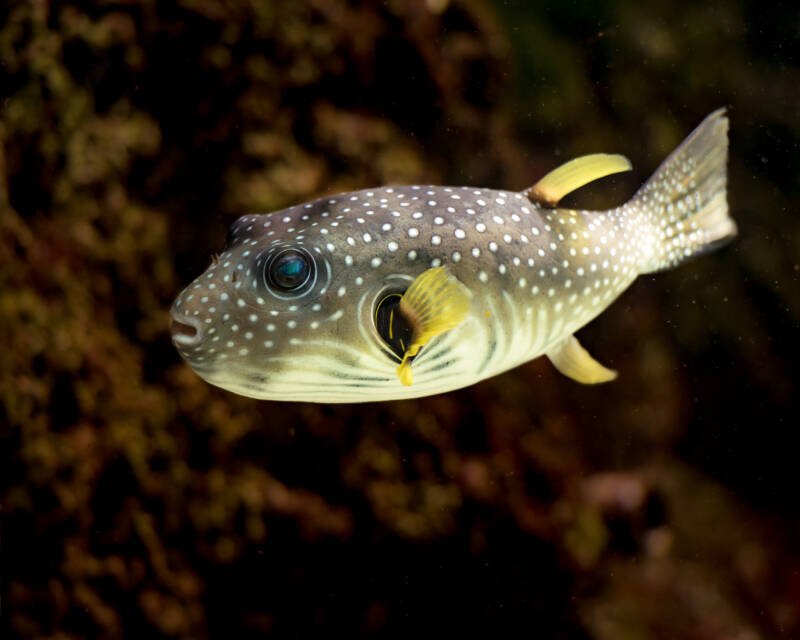
Specific Gravity: 1.020 to 1.025
Minimum Tank Size: 200 gallons
The stars and stripes puffer (Arothron hispidus), also known as the white-spotted puffer, hails from the Indo Pacific region.
It is predominantly dark-colored with numerous bright white dots on its back and horizontal lines on its belly.
These fish are very smart, highly interactive, and grow to a size of 16 to 18 inches (40 to 46 cm).
These fish are hardy and can be kept with larger, quick-swimming tank mates. Although it is a large fish, it is gentle and should not be paired with aggressive tank mates.
Plan on installing a decent filter as they produce a fair amount of waste.
14. Siamese Tiger Fish
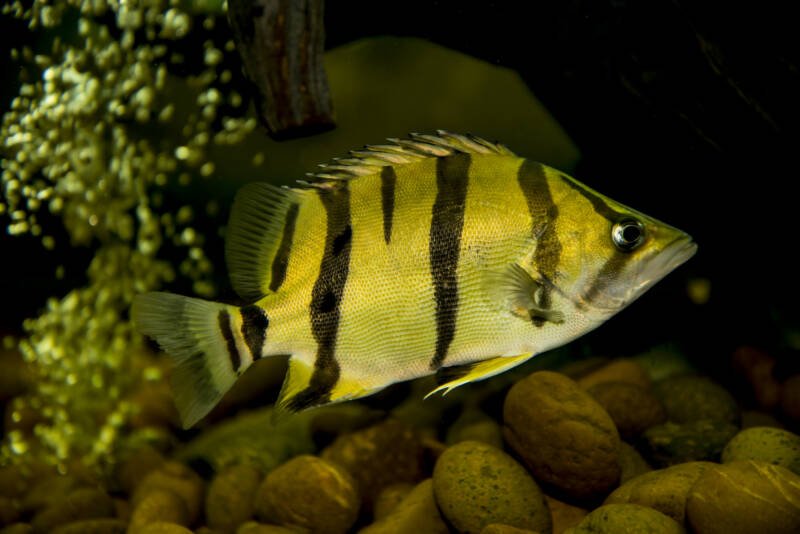
Specific Gravity: 1.002 to 1.007
Minimum Tank Size: 100 gallons
The Siamese tiger fish (Datnioodes pulcher) comes from the Mekong, Mae Klong, and Chao Phraya basins’ waters.
A large brackish species, the Siamese tiger fish reaches 18 inches (45.7 cm) in the wild but may stay around nine to twelve inches (23 to 30.5 cm) range in an aquarium setting.
This carnivorous fish is yellow-brown in color, with five to seven vertical black bars.
They are predatory fish and are labeled semi-aggressive, although they do well in tanks with similarly sized species.
They require a large tank with low salinity, a good filtration system, and regular water changes.
15. Endlers
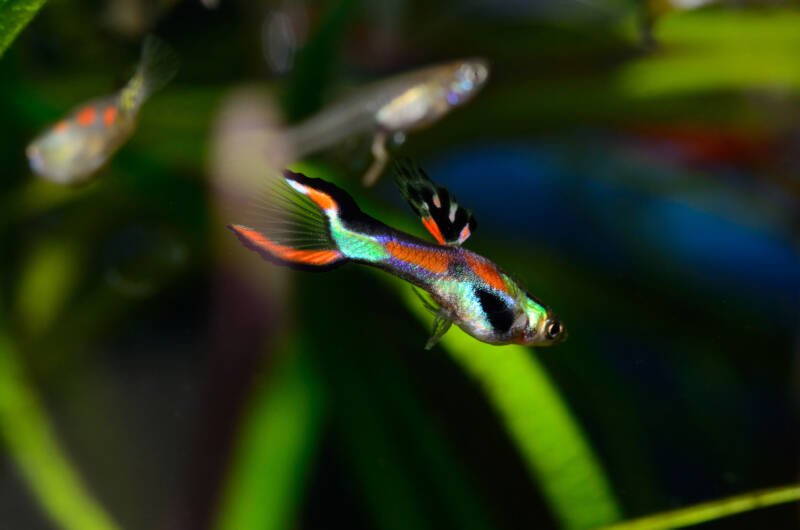
Specific Gravity: 1.000 to 1.022
Minimum Tank Size: 10 gallons
A third Poecilia member that is great for brackish water aquariums is the Endler.
Capable of living in both freshwater and brackish, this small fish is extremely hardy. It can tolerate wide ranges in water pH, hardness, and temperature as well.
Another very active species, Endlers, will explore all tank areas, often shoaling during the day and resting near the bottom at night.
Males of the species grow to about one inch (2.5 cm) in length and feature vibrant neon in practically every color of the rainbow.
Females can grow up to twice as long and do not possess the same coloration.
15. Red Claw Crab

Specific Gravity: 1.005
Minimum Tank Size: 10 gallons
The red claw crab (Perisesarma bidens) is a smaller, semi-aquatic crab that lives in shallow water bodies in Asia.
It grows to a length of four inches (10 cm). Its body is brown with some spots, and it has prominent red claws that are tipped with orange or yellow.
Access to dry land is critical for this species. Go with a land/aquatic layout and make sure there are plenty of hiding spaces as the crab needs protection each time it molts.
Red claw crabs can be destructive with live plants, so keep that in mind when planning aquarium decorations.
Keep a tight-fitting lid on your tank, too, as these little guys can escape.
16. Olive and Zebra Nerite Snail

Specific Gravity: 1.004 to 1.007
Minimum Tank Size: 5 gallons
The olive nerite (Neritina reclivata) and zebra nerite (Neritina natalensis) snails are popular choices for brackish tank detritus and algae-eaters.
In the wild, these creatures thrive in a wide variety of environments, from fresh to brackish water with varying water levels.
The zebra snail comes in a range of base colors from brown to green to yellow/gold, with uneven stripes circling its shell. It can grow to a length of one to 1.2 inches (2.5 to 3 cm).
The olive snail is olive or green/brown colored and is another large snail, attaining a length of just under one inch (2.5 cm).
17. Lava Snails

Specific Gravity: 1.002 to 1.025
Minimum Tank Size: 10 gallons
Lava snails (Faunus ater), also called black devil snails, are native to the lower river regions of Southeast Asia.
Omnivorous bottom feeders, they grow to a length of 2 to 3.5 inches (5 to 9 cm). Their shell colors vary from dark black to chocolate brown and narrow to a sharp point.
While this species can live in freshwater, they cannot successfully breed outside of brackish water.
Avoid overcrowding your aquarium with plants to give your snail room to move. Also, to the extent possible, keep plants away from your snails as they may snack on them.
Your snails will peacefully scavenge for food along the substrate, eating algae and decaying plant matter.
18. Kribensis

Specific Gravity: less than 1.0002
Minimum Tank Size: 20 gallons
The kribensis (Pelvicachromis pulcher) is a dwarf cichlid with a native habitat of southern Nigeria and coastal Cameroon.
In the wild, they inhabit both blackwater streams and river deltas; thus, they can tolerate both freshwater and slightly brackish water.
Their silver body has a dark horizontal band running its length. Their fins are accented in a range of colors, including red, orange, green, and blue.
Females will have a prominent red spot on their belly when spawning. These fish are bottom-dwelling cave lovers that can be slightly territorial.
They are omnivores that will accept a variety of sinking commercial and live foods.
Closing Thoughts
Certainly, the variety of species and the uniqueness of a brackish water tank make it a fun and rewarding activity.
Carefully consider the species you choose, know their ideal tank setup and water requirements, and maintain consistent water conditions.
These steps will go a long way toward keeping your fish happy and healthy.
Tell us your favorite species to keep in a brackish water tank!
We welcome your stories and comments below.